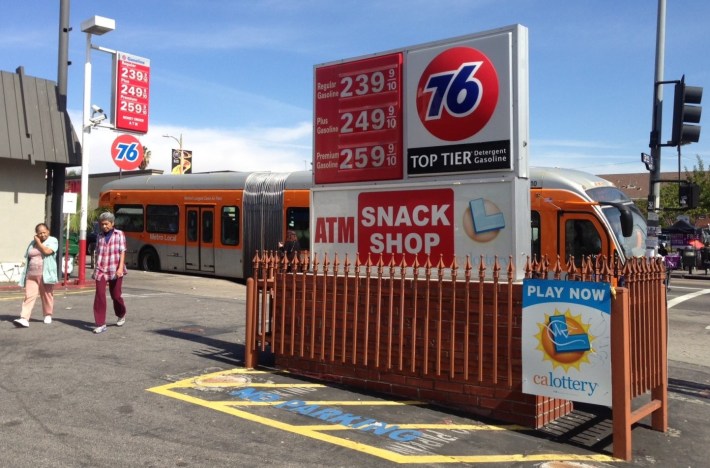
The Federal Highway Administration recently released figures showing that U.S. driving is way up. In 2015, for the first time in nearly a decade, Americans drove more than the year before. In fact, the 2015 vehicle miles traveled surpassed the previous high from 2007.
Christopher Ingraham at the Washington Post's Wonkblog parses the numbers, and finds that the total number of miles driven in the country increased by four percent last year, the biggest jump in a single year since the late 1980s.
In California, according to the report [PDF], driving increased a lot more than that. On all roads, driving in California increased 11.3 percent over 2014. The increase was highest on urban aterials (11.5 percent over 2014).
California's population has grown, and these numbers reflect overall growth. For the record, per capita driving has pretty much held steady, according to Ingraham; in 2015 per capita driving ticked upward, but it remains below year 2000 levels. In regards to congestion, emissions, and crashes, the overall numbers tell the story more clearly than per capita numbers.
Why all the driving?
One factor is today's inexpensive gas. Gas has not been this cheap since 2004.
Falling gas prices means falling gas tax revenue, even if some people do buy more of it. Part of California's complicated gas tax formula—do you really want to know the details?—includes sales taxes on gasoline. The sales taxes are based on a percentage of the price, not set at a per-gallon amount. Those go up and down with the price of gas. In addition, part of the per-gallon tax is readjusted every year to keep it “revenue neutral,” and the Board of Equalization just today voted to lower it again this coming July.
Today's cars are more fuel-efficient, which means fewer gallons of gas bought per mile driven, which further reduces revenue from gas taxes.
Fuel efficiency is good, but it comes with a down side. The gas tax used to be the source of money to keep roads maintained. Not anymore; about half of California's transportation funding now comes from local sales taxes, which is paid by everyone, not just drivers. Generally those sales tax measures are slated for specific capital projects, not for maintenance, which, as every county in California has been complaining about, is badly needed. With gas tax revenues in decline, there is less and less money to maintain what we have already built, let alone to maintain all the new overpasses and road widenings on the books—or on hold, now that the state is cutting transportation funds.
The ongoing—or maybe stalled, depending on your perspective—Special Session on Transportation in the California legislature has not been able to tackle this problem. Legislators and others keep demanding that we “fix our roads” but few will agree on how to pay for the fix. The most straightforward solution would be to recalibrate—ahem, raise—the gas tax. Senator Jim Beall, at least, is brave enough to say California needs to raise its gas tax, but his transportation funding bill is moving glacially through the legislative process. And there are livability drawbacks to raising gas taxes.
And a pilot program to test the concept of a road users charge is gearing up, but the pilot is just a simulation, with actual road charges still years away.
As cheap gas encourages people to drive more, it is also contributing to traffic congestion, which tends to drive people crazy. According to Ingraham, the average time commuters spend stuck in traffic is now 42 hours a year, more than double what was already bad in 1982.
Worse, more driving will do a number on California's efforts to fight climate change. More driving produces more greenhouse gas emissions and more air pollution—and may do so for a long time to come. It also is making life a lot more dangerous for everyone, drivers as well as people on foot or bikes, with higher roadway fatalities following the upward trend in driving.
So, yes, it is glorious that we can spend a little less on filling our tanks and a little more on food or housing or something, anything else—but we are paying a high price for that cheap gas.





